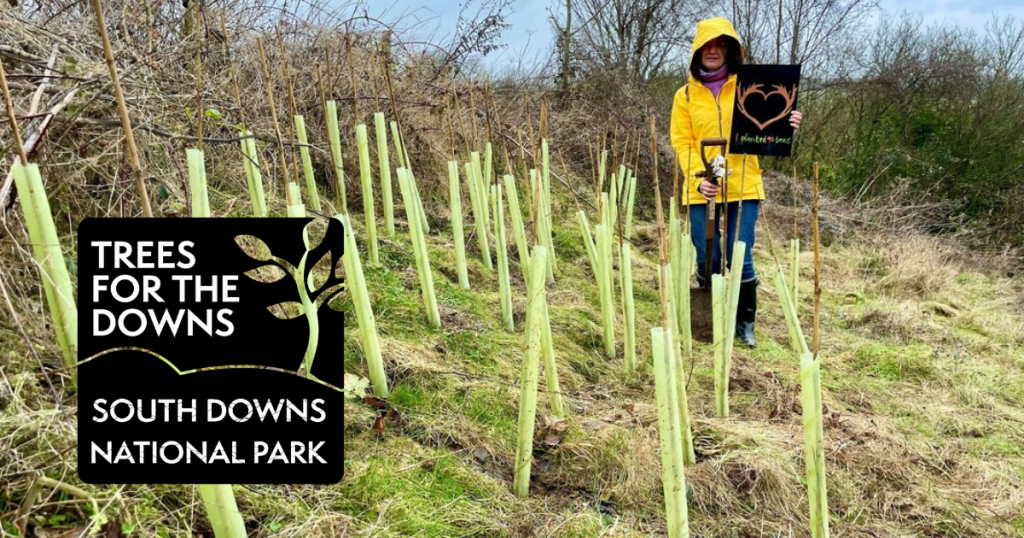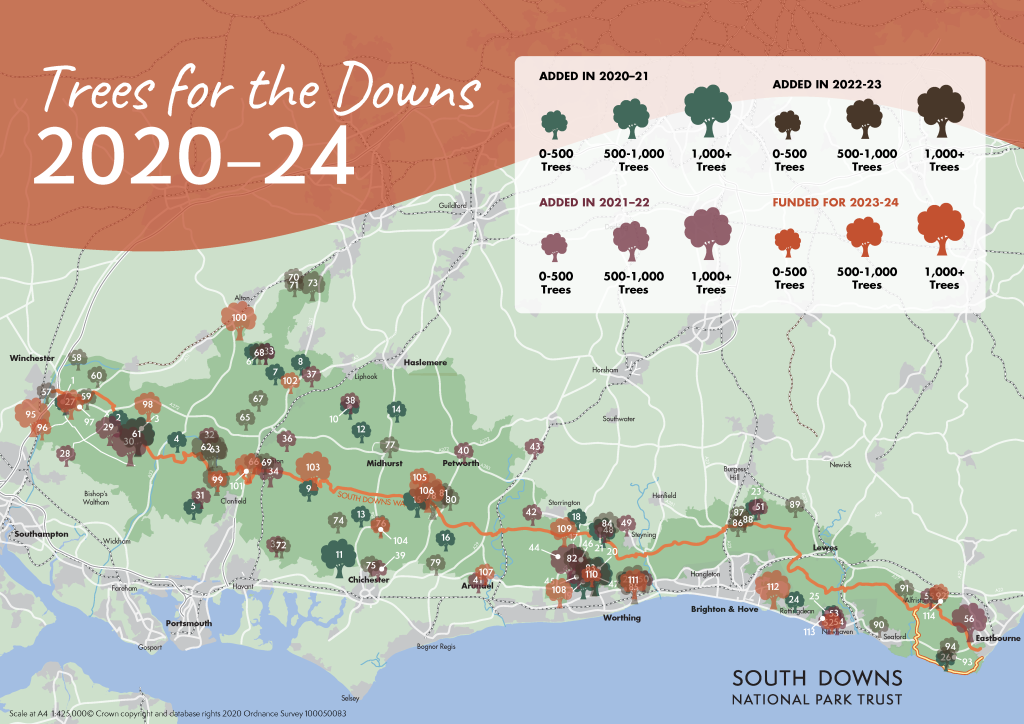More than 23,000 trees are being planted this winter across the South Downs National Park to help wildlife flourish and increase resilience to climate change.
As National Tree Week gets under way on 25 November, scores of trees are going into the ground at 20 new sites across Sussex and Hampshire.
It’s yet another big step forward as the Trees for the Downs campaign edges closer to its target of planting 100,000 trees across the region. The initiative was launched exactly four years ago and this new phase of planting will mean well over 60,000 new trees across 114 different sites.

The tree planting is restoring those lost to pests and diseases, including Ash Dieback and Dutch Elm Disease, as well as creating new habitat for wildlife and amenity value for local communities. The trees are a mixture of disease-resistant elm trees and native species, such as oak and black poplar, and sites include schools, farms, recreation grounds and historic parks.
Image shows some of the 1500 trees planted at Wild Heart Hill over the winter of 2021-22 – Wild Heart Hill
The tree planting is restoring those lost to pests and diseases, including Ash Dieback and Dutch Elm Disease, as well as creating new habitat for wildlife and amenity value for local communities. The trees are a mixture of disease-resistant elm trees and native species, such as oak and black poplar, and sites include schools, farms, recreation grounds and historic parks.
The planting has been made possible by generous donations from the public and businesses to the South Downs National Park Trust, the official independent charity for the National Park. A boost came from The American Express Foundation’s grant to National Parks UK, part of which went to Trees for the Downs and meant 5,000 trees could be planted. American Express colleagues also provided volunteering support.
Around £230,000 has been raised so far and further donations will mean even more trees can be planted.
It comes as research from the Woodland Trust shows one third of all woodland species in the UK are in decline and one in 10 is at risk of extinction.
Nick Heasman, a Countryside and Policy Manager for the National Park, said: “Our treescape supports a wealth of wildlife, from rare insects, to nesting birds and complex fungi. They also give us air to breathe, with a single mature tree producing enough oxygen in a year to sustain 10 people.
“However, our wonderful trees are under unprecedented threat from an ever-increasing number of pests and diseases, as well as climate change.
“They’re under threat from climate change, but trees are also part of solution as the ultimate carbon capturer. The entire woodland ecosystem plays a massive role in locking up carbon, including the wood, roots, leaves, soils and associated plants.
“Increasing the number and diversity of our native trees, and carefully introducing new species into the landscape, is going to be a big help in responding to all these threats and also helping to reverse biodiversity loss.
“By the end of this winter, we’ll have planted over 60,000 trees as part of Trees for the Downs and it’s something we can all be proud of. None of it would have been possible without the support of local communities and businesses who have gone the extra mile to give back to nature and I’d like to say a big ‘thank you’.

“Trees for the Downs is a key part of the National Park’s inspiring ReNature drive, which is seeking to create thousands of hectares of new wildlife havens to help nature bounce back and it continues to go from strength to strength.”
A batch of trees are being delivered this winter to Woodingdean, near Brighton. Clare Millett Hopkins, Chair of Woodingdean Wilderness Group, said: “We are a small volunteer-led community-based conservation group, passionate about boosting wildlife biodiversity and connectivity of habitats in our urban fringe location on the edge of the National Park. We’ll be involving our community in a planting event to help plant out the 1000 native deciduous trees in December. It is a lovely opportunity to bring everyone together, of all ages, to plant the trees and support our wildlife and build an appreciation for our natural environment.”
Cllr Chris Corcoran, from Twyford Parish Council, in Hampshire, said: “When a group of Twyford residents signed up to support tree planting in the village Twyford Parish Council stepped forward to help. It proposed an avenue along the Shawford Road with a clump at the end, at one of the entrances into the National Park. The Trees for the Downs initiative has been the perfect partner. It raises the profile, ensures we are planting the right trees in the right places and it supplies the 30 trees we need.”
Trees for the Downs has been made possible with special thanks to: The many individuals who have donated, American Express Foundation, Aspinal of London, The Boltini Trust, Chalk Cliff Trust, Friends of the South Downs, Higgidy, Jude’s, Nyetimber, South East Water, Southern Co-op and Willmott Dixon.
During National Tree Week, a number of American Express colleagues, based at the company’s Brighton and Burgess Hill offices, will be rolling up their sleeves to help with coppicing and hedgelaying at a site near Lewes.
To donate to Trees for the Downs, or to make an application for potential tree planting next year, visit the Trees for the Downs fund page. The deadline for applications is 29 February, 2024.
